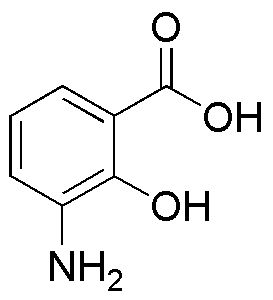3-Aminosalicylic acid is widely utilized in research focused on:
- Tuberculosis Treatment: This compound is primarily known for its role as an anti-tubercular agent, often used in combination therapies to combat multidrug-resistant strains of tuberculosis.
- Pharmaceutical Development: It serves as a key intermediate in the synthesis of various pharmaceuticals, particularly in the development of drugs targeting bacterial infections.
- Analytical Chemistry: Researchers use it as a standard in chromatographic techniques to ensure accurate quantification of similar compounds in complex mixtures.
- Biochemical Research: It is employed in studies investigating the mechanisms of action of anti-tubercular drugs, helping to enhance understanding of drug resistance.
- Formulation Science: The compound is utilized in the formulation of topical treatments due to its anti-inflammatory properties, providing relief in skin conditions.
General Information
Properties
Safety and Regulations
Applications
3-Aminosalicylic acid is widely utilized in research focused on:
- Tuberculosis Treatment: This compound is primarily known for its role as an anti-tubercular agent, often used in combination therapies to combat multidrug-resistant strains of tuberculosis.
- Pharmaceutical Development: It serves as a key intermediate in the synthesis of various pharmaceuticals, particularly in the development of drugs targeting bacterial infections.
- Analytical Chemistry: Researchers use it as a standard in chromatographic techniques to ensure accurate quantification of similar compounds in complex mixtures.
- Biochemical Research: It is employed in studies investigating the mechanisms of action of anti-tubercular drugs, helping to enhance understanding of drug resistance.
- Formulation Science: The compound is utilized in the formulation of topical treatments due to its anti-inflammatory properties, providing relief in skin conditions.
Documents
Safety Data Sheets (SDS)
The SDS provides comprehensive safety information on handling, storage, and disposal of the product.
Product Specification (PS)
The PS provides a comprehensive breakdown of the product’s properties, including chemical composition, physical state, purity, and storage requirements. It also details acceptable quality ranges and the product's intended applications.
Certificates of Analysis (COA)
Search for Certificates of Analysis (COA) by entering the products Lot Number. Lot and Batch Numbers can be found on a product’s label following the words ‘Lot’ or ‘Batch’.
Numéro de catalogue
Numéro de lot/série
Certificates Of Origin (COO)
This COO confirms the country where the product was manufactured, and also details the materials and components used in it and whether it is derived from natural, synthetic, or other specific sources. This certificate may be required for customs, trade, and regulatory compliance.
Numéro de catalogue
Numéro de lot/série
Safety Data Sheets (SDS)
The SDS provides comprehensive safety information on handling, storage, and disposal of the product.
DownloadProduct Specification (PS)
The PS provides a comprehensive breakdown of the product’s properties, including chemical composition, physical state, purity, and storage requirements. It also details acceptable quality ranges and the product's intended applications.
DownloadCertificates of Analysis (COA)
Search for Certificates of Analysis (COA) by entering the products Lot Number. Lot and Batch Numbers can be found on a product’s label following the words ‘Lot’ or ‘Batch’.
Numéro de catalogue
Numéro de lot/série
Certificates Of Origin (COO)
This COO confirms the country where the product was manufactured, and also details the materials and components used in it and whether it is derived from natural, synthetic, or other specific sources. This certificate may be required for customs, trade, and regulatory compliance.


